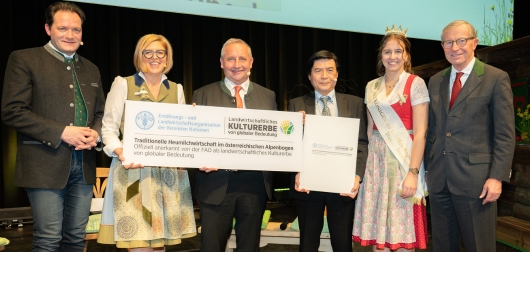Glückwunsch! Hay Milk in Austria celebrates its recognition as FAO global agricultural heritage
Salzburg.- Austria, marked a significant milestone as it celebrated the formal recognition of Traditional Hay Milk Farming in the Austrian Alpine Arc as a FAO Globally Important Agricultural Heritage System (GIAHS). The event, attended by 800 guests, mainly farmers from the region, included the participation of Salzburg Governor, Wilfried Haslauer, and GIAHS Coordinator, Endo Yoshihide, representing the Food and Agriculture Organization of the United Nations.
"The designation of hay milk farming as agricultural world heritage is not only a recognition for the hay milk farmers but also a commitment to preserving and further developing this sustainable form of farming," said Karl Neuhofer, chairman of the ARGE Hay Milk, during the event.
Norbert Totschnig, Austrian Federal Minister for Agriculture, Regions, and Water Resources, added, "Our hay milk is a piece of Austrian tradition that combines sustainability, quality, and regionality. I am proud that our hay farming is now recognized as a global specialty. It is an award for our agriculture, our ecology, our cultural landscape, and our traditional farming methods. I am convinced that with the recognition as world heritage, awareness of hay milk will continue to increase across borders."
Hay milk in Austria
The production of hay milk, from cattle fed on fresh grass and hay rather than fermented fodder, is as old as the keeping of dairy animals in Europe. Using hay as a nutrient-rich winter feed helps ruminants get through the vegetation-less cold season, thus ensuring the livelihood of farming families.
Hay milk used to make up most of Austria’s milk production, but now it accounts for only 15 percent. Austria’s 6,500 hay milk farmers and 60 major processors have come together in the ARGE Heumilch Österreich community. Its aim is to preserve hay farming and communicate the benefits of this sustainable method to obtain a fair milk producer price in the marketplace.
Added value for Hay Milk farmers
Since the launch of the marketing campaign by ARGE Hay Milk Austria, value creation, sales, and awareness of hay milk have steadily increased both domestically and internationally. The annual 590 million kilograms of hay milk are fully marketed. "The added value for hay milk farmers is now 30 million euros per year. Our goal is to maintain this high level of value," said Christiane Mösl, managing director of ARGE Hay Milk, today. "Many consumers appreciate the quality of hay milk. The award supports us in continuing to educate about the special farming practices and their benefits for the environment and biodiversity. In our spring campaign, starting in March, we will once again attract a lot of attention to hay milk in Austria and Germany with the headline 'World-class. Hay milk is a world heritage site,'" said Mösl.
About Hay Milk
ARGE Hay Milk unites approximately 7,000 hay milk farmers, as well as more than 70 dairies, cheese dairies, alpine dairies, and marketers in Austria and the Allgäu region. ARGE members work according to strict standards, compliance with which is monitored by independent, state-certified bodies. Currently, approximately 590 million kilograms of Hay milk are collected annually. Main production areas are Vorarlberg, Tyrol, Salzburg, Upper Austria, Styria, as well as Bavaria and Baden-Württemberg. The European Union awarded hay milk with the EU quality label g.t.S. - guaranteed traditional specialty - in 2016.
More information:
GIAHS webpage: Traditional Hay milk Farming in the Austrian Alpine Arc, Austria
Hay Milk: https://www.heumilch.com/
Source: ARGE Heumilch
Photo caption
From left to right: Norbert Totschnig, Federal Minister of Agriculture; Christiane Mösl, Managing Director of ARGE Heumilch; Karl Neuhofer, Chairman of ARGE Heumilch; Endo Yoshihide, FAO-GIAHS Coordinator; Simea Barth, “Hayqueen”; and Wilfried Haslauer, Provincial Governor of Salzburg.


